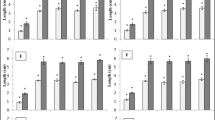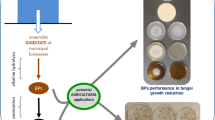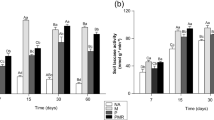Abstract
Cresols are ubiquitous in nature due to their bulk production and end uses in various industrial processes as well as due to their natural presence. They are highly toxic to both fauna and flora and are included in the list of priority pollutants. In the present study, the effect of m-cresol on germination of ten different crop seeds was tested and the seeds of okra and eggplant were found to be very sensitive, okra being the most vulnerable. Okra seeds lost its viability in the presence of m-cresol, which was proportionate to its concentration as indicated by the standard 2,3,5-tetrazoliumtrichloride (TTC) test. Marked decrease in protease and amylase activities was observed in germinating seeds exposed to the compound. The inhibitory effect of m-cresol on germination was eliminated effectively by bioaugmentation of the soil with the cresol-degrading Pseudomonas monteilii S-CSR-0014. Normal germination and seedling vigor were obtained when the seeds were sown four and eight days after the soil inoculation with the bacterial cells, whereas the seeds sown immediately did not show proper germination. The inoculated bacterium degraded m-cresol efficiently from the spiked soil and exhibited concomitant growth. It can be concluded that m-cresol-contaminated soils could be effectively bioremediated to render the soil suitable for normal seed germination and healthy seedling growth of sensitive crops.





Similar content being viewed by others
References
Transparency Market Research (2020) Cresols market size, sales, share and forecasts by 2027. Press release. Transparency Market Research, Albany NY 12207, United States. https://www.transparencymarketresearch.com/cresols-market.html. Accessed 14 May 2020
WHO (World Health Organization) (1996) Cresols health and safety guide, Health and Safety Guide No. 100. World Health Organization, Geneva
U.S. Epa (United States Environmental Protection Agency) (1999) Integrated risk information system (IRIS) on tricresol. National Center for Environmental Assessment Office of Research and Development, Washington, DC
Guan X, Poon K (2012) Higher phytotoxicity of o-cresol to local Chinese vegetables. Elec J Environ Agric Food Chem 11:38–43
Krishnan SN, Nayarisseri A, Usha R (2018) Biodegradation effects of o-cresol by Pseudomonas monteilii SHY on mustard seed germination. Bioinformation 14(6):271–278. https://doi.org/10.6026/97320630014271
Blum U (2011) Plant-plant allelopathic interactions: phenolic acids, cover crops and weed emergence. Springer Science & Business Media B.V. ISBN 9400706839, 9789400706835
Inderjit, Dakshini KMM, Foy CL (eds) (1999) Principles and practices in plant ecology: allelochemical interactions. CRC Press. ISBN 0849321166, 9780849321160
Li ZH, Wang Q, Ruan X, Pan CD, Jiang DA (2010) Phenolics and plant allelopathy. Molecules 15(12):8933–8952. https://doi.org/10.3390/molecules15128933
Trezzi MM, Vidal RA, Balbinot Junior AA, Bittencourt HVH, Souza Filho APS (2016) Allelopathy: driving mechanisms governing its activity in agriculture. J Plant Interact 11(1):53–60. https://doi.org/10.1080/17429145.2016.1159342
DellaGreca M, Monaco P, Pinto G, Pollio A, Previtera L, Temussi F (2001) Phytotoxicity of low-molecular-weight phenols from olive mill wastewaters. Bull Environ Contam Toxicol 67:352–359. https://doi.org/10.1371/journal.pone.0139992
Fiorentino A, Gentili A, Isidori M, Monaco P, Nardelli A, Parrella A, Temussi F (2003) Environmental effects caused by olive mill wastewaters: toxicity comparison of low-molecular-weight phenol components. J Agric Food Chem 51:1005–1009
Isidori M, Lavorgna M, Nardelli A, Parella A (2005) Model study on the effect of 15 phenolic olive mill wastewater constituents on seed germination and Vibrio fischeri metabolism. J Agric Food Chem 53:8414–8417
Komilis DP, Karatzas E, Halvadakis CP (2005) The effect of olive mill wastewater on seed germination after various treatment techniques. J Environ Manag 74:339–348
Linares A, Caba JM, Ligero F, de la Rubia T, Martınez J (2003) Detoxification of semisolid olive-mill wastes and pine-chip mixtures using Phanerochaete flavido-alba. Chemosphere 51:887–891
Sampedro I, Romero CN, Ocampo JA, Brenes M, Garciäa I (2004) Removal of monomeric phenols in dry mill olive residue by saprobic fungi. J Agric Food Chem 52:4487–4492. https://doi.org/10.1021/jf0400563
Jiang Q, Zhou C, Wang Y, Si F, Zhou Y, Chen B, Zhao Y, Chen J, Xiao M (2014) Pseudomonas stutzeri strain possessing a self-transmissible TOL-like plasmid degrades phenol and promotes maize growth in contaminated environments. Appl Biochem Biotechnol 172:346–3475. https://doi.org/10.1007/s12010-014-0785-6
Wang Y, Song J, Zhao W, He X, Chen J, Xia M (2011) In situ degradation of phenol and promotion of plant growth in contaminated environments by a single Pseudomonas aeruginosa strain. J Hazard Mater 192:354–360. https://doi.org/10.1016/j.jhazmat.2011.05.031
Poon K, Hon KL, Huang JJ (2011) The phytotoxicity of 2,4,6-trichlorophenol and phenol to local agricultural plant species in China. In: Popov V, Brebbia CA (eds) Food and environment: the quest for a sustainable future. WIT Trans Ecol Environ 152:203–213. https://doi.org/10.2495/FENV110201
Amrutha Vijay PT, Sahila MM, Kunhi AAM (2020) Soil bioaugmentation with Pseudomonas aeruginosa S-CSR-0013 eliminates the inhibitory effect of phenol on germination of chickpea (Cicer arietinum) seeds. J Environ Sci Pollut Res 6(2):420–425
Lancaster ZD, Norsworthy JK, Scott RC (2018) Residual activity of ACCase-inhibiting herbicides on monocot crops and weeds. Weed Technol 32(4):364–370
Krueger JP, Butz RG, Cork DJ (1991) Use of dicamba-degrading microorganisms to protect dicamba susceptible plant species. J Agric Food Chem 39:1000–1003
Grabińska-Sota E, Wiśniowska E, Kalka J (2003) Toxicity of selected synthetic auxines, 2,4-D and MCPA derivatives to broad-leaved and cereal plants. Crop Prot 22:355–360. https://doi.org/10.1016/S0261-2194(02)00178-3
Bidlan R, Afsar M, Manonmani HK (2004) Bioremediation of HCH-contaminated soil: elimination of inhibitory effects of the insecticide on radish and green gram seed germination. Chemosphere 56:803–811
Ajithkumar PV, Gangadhara KP, Manilal P, Kunhi AAM (1998) Soil inoculation with Pseudomonas aeruginosa 3mT eliminates the inhibitory effect of 3-chloro- and 4-chlorobenzoate on tomato seed germination. Soil Biol Biochem 30:1053–1059. https://doi.org/10.1016/S0038-0717(97)00249-6
Gangadhara KP, Kunhi AAM (2000) Protection of tomato seed germination from the inhibitory effect of 2,4,5-trichlorophenoxyaceticacid by inoculation of soil with Burkholderia cepacia AC1100. J Agric Food Chem 48:4314–4319. https://doi.org/10.1021/jf990598y
Adams GO, Fufeyin PT, Okoro SE, Ehinomen I (2015) Bioremediation, biostimulation and bioaugmention: a review. Int J Environ Bioremediat Biodegradat 3:28–39. https://doi.org/10.12691/ijebb-3-1-5
Azubuike CC, Chikere CB, Okpokwasili GC (2016) Bioremediation techniques–classification based on site of application: principles, advantages, limitations and prospects. World J Microbiol Biotechnol 32:180. https://doi.org/10.1007/s11274-016-2137-x
Winardi, Soetatrto ES, Haryono E, Sudrajat (2019) Research roadmap of bioremediation: review of in situ method on land bioremediation. IOP Conf Series J Phys: Conf Ser 1175:012130. https://doi.org/10.1088/1742-6596/1175/1/012130
Ahamad PYA, Kunhi AAM (1999) Degradation of high concentrations of cresols by Pseudomonas sp. CP4. World J Microbiol Biotechnol 15:321–323
Ho K-L, Chen Y-Y, Lee D-J (2010) Functional consortia for cresol degrading activated sludges: toxicity-to-extinction approach. Bioresour Technol 101:9000–9005
Perron N, Welander U (2004) Degradation of phenol and cresols at low temperatures using a suspended-carrier biofilm process. Chemosphere 55:45–50
Shainy NK, Usha R (2018) Aerobic batch degradation of cresol by newly isolated Pseudomonas monteiliiCr13. J Pure Appl Microbiol 12(1):309–315. https://doi.org/10.22207/JPAM.12.1.37
Surkatti R, El-Naas MH (2018) Competitive interference during the biodegradation of cresols. Int J Environ Sci Technol 15:301–308. https://doi.org/10.1007/s13762-017-1383-2
Ameera K (2016) Comparative study on biodegradation of o-cresol by free and immobilized Pseudomonas cells in agar and calcium alginate beads. M.Sc. Dissertation, University of Calicut, Thenjipalam - 673635
ISTA (International Seed Testing Association) (1985) International rules for seed testing. Annex Seed Sci Technol 13:356–513
ISTA (International Seed Testing Association) Rules 2009 (2009) International Seed Testing Association, Bassersdorf, Switzerland
Laskowsky M (1955) Trypsinogen and trypsin. Methods Enzymol 11:26–36
Bernfeld P (1955) Amylases: alpha and beta. Methods Enzymol 1:149–158
Lacoste RJ, Venabe SH, Stone JC (1959) Modified 4-aminoantipyrene colorimetric method for phenol. Application of an acrylic monomer. Anal Chem 131:1246–1249
Peterson MM, Horst GL, Shea PJ, Comfort SD, Peterson RKD (1996) TNT and 4-amino-2,6-dinitrotoluene influence on germination and early seedling development of tall fescue. Environ Pollut 93:57–62
Politycka B, Wojcik-Wojtkoviak D, Pudeliski T (1985) Phenolic compounds as a cause of phytotoxicity in greenhouse substrates repeatedly used in cucumber growing. In: Skierkowski J (ed) ISHS Acta Horticulturae 156, XII Working Party on Greenhouse Cucumbers. Skierniewice, Poland. URL www.actahort.org
Al Harun MAY, Johnson J, Uddin MN, Robinson RW (2015) Identification and phytotoxicity assessment of phenolic compounds in Chrysanthemoides monilifera subsp. monilifera (Boneseed). PLoS ONE 10(10):e0139992. 1–19. https://doi.org/10.1371/journal.pone.0139992
Politycka B, Seidler-Lożykowska K (2009) Phytotoxicity and phenolic compounds content in soil during long-term cultivation of lemon balm (Melissa officinalis L.) and its effect on herb yield and essential oil content. Kerba Pol 55:133–139
Yukiko I, Yasuo K, Minoru T (2001) Effects of phenolic compounds on seed germination of shirakamba birch, Betula platyphylla var. japonica. Eurasian J For Res 2:17–25
Siddiqui ZS, Ahmed S (1996) Effect of systemic fungicides on seed germination, seedling growth and phenolic content of Vigna radiata. Pak J Bot 28:191–193
Ali AS, Elozeiri AA (2017) Metabolic processes during seed germination. Chapter 8. In: Jimenez-Lopez JC (ed) Advances in seed biology. IntechOpen, p 141–146. https://doi.org/10.5772/intechopen.70553
Ghavidel RA, Prakash J, Davoodi MG (2011) Assessment of enzymatic changes in some legume seeds during germination. Agro FOOD Ind Hi Tech 22:45–47
Rani K, Kant S, Goyal S, Saini A, Gupta C (2014) A novel comparative assessment of extracted amylase activity in germinating and germinated seeds of Cicer arietinum, Ceci neri, and Pisum sativum. Int J Pure Appl Biosci 2(2):191–193
Hayat R, Ali S, Amara U, Khalid R, Ahmed I (2010) Soil beneficial bacteria and their role in plant growth promotion: a review. Ann Microbiol 60:579–598. https://doi.org/10.1007/s13213-010-0117-1
Radhapriya P, Ramachandran A, Anandham R, Mahalingam S (2015) Pseudomonas aeruginosa RRALC3 enhances the biomass, nutrient and carbon contents of Pongamia pinnata seedlings in degraded forest soil. PLoS ONE 10(10):1-19. e0139881. https://doi.org/10.1371/journal.pone.0139881
Acknowledgements
The authors would like to thank the Governing Board of SAFI Institute of Advanced Study, Vazhayoor East and the Trustees of Social Advancement Foundation of India (SAFI), Vazhayoor East for providing the facilities, their continued support for the work, and the permission to publish the data.
Author information
Authors and Affiliations
Contributions
Conceptualization: [AAMK]; Methodology: [AAMK]; Formal analysis and investigation: [MA, TCS, and SVM]; Writing --original draft preparation: [SVM]; Writing --review and editing: [AAMK]; Funding acquisition: [AAMK]; Resources: [AAMK]; Supervision: [AAMK].
Corresponding author
Ethics declarations
Conflict of interest
None of the authors have any conflicting interests in the manuscript.
Ethical Approval
This paper has not been published before in any form and it is not under consideration by any other journal at the same time. All the authors approve the manuscript submission to this journal and none of the authors has any conflicting interests in the manuscript.
Additional information
Publisher's Note
Springer Nature remains neutral with regard to jurisdictional claims in published maps and institutional affiliations.
Rights and permissions
About this article
Cite this article
Ajisha, M., Shaima, T.C., Menon, S.V. et al. Bioaugmentation of Soil with Pseudomonas monteilii Strain Eliminates Inhibition of Okra (Abelmoschus esculentus) Seed Germination by m-Cresol. Curr Microbiol 78, 1892–1902 (2021). https://doi.org/10.1007/s00284-021-02438-4
Received:
Accepted:
Published:
Issue Date:
DOI: https://doi.org/10.1007/s00284-021-02438-4




